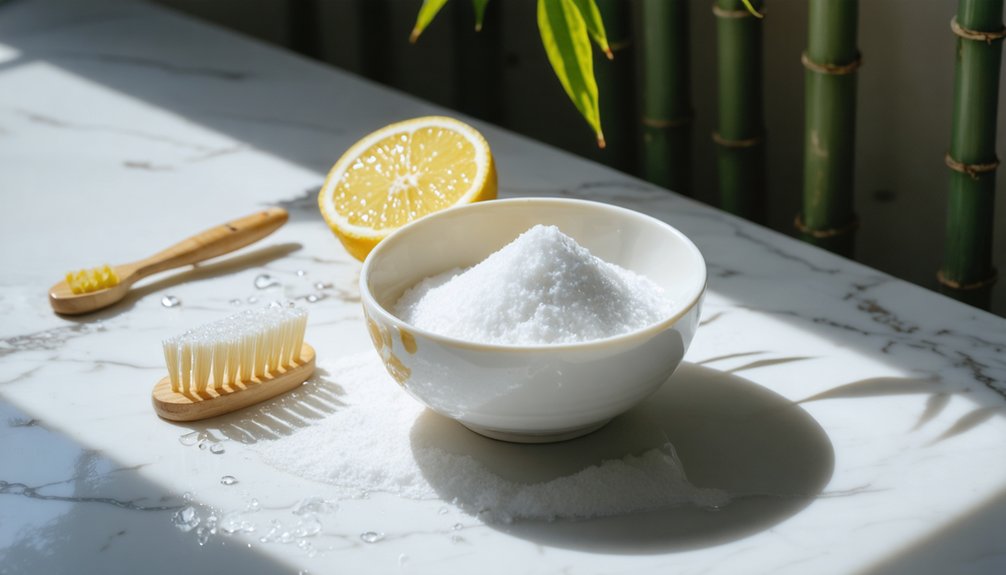To safely whiten your teeth with baking soda, create a simple paste by mixing a small amount with water. Gently brush for two minutes using light pressure, and limit applications to once or twice weekly to prevent sensitivity. This natural method effectively removes surface stains from coffee, tea, and tobacco while neutralizing harmful oral acids. For best results, maintain good oral hygiene and reduce consumption of staining substances. The following guidelines will help you achieve noticeable results while protecting your enamel.
Key Takeaways
- Mix one teaspoon of baking soda with water until you achieve a smooth paste consistency for gentle brushing.
- Apply the baking soda paste directly to teeth using a soft toothbrush and brush gently for two minutes.
- Use this method no more than twice per week, maintaining gentle pressure to protect tooth enamel.
- Rinse thoroughly with water after application and follow with regular toothpaste to restore fluoride protection.
- Combine with good oral hygiene and reduced consumption of staining beverages for optimal whitening results.
Safe Usage and Benefits of Baking Soda Whitening
While baking soda has gained popularity as a DIY teeth whitening solution, its effectiveness stems primarily from mechanical stain removal rather than chemical bleaching. Research confirms that baking soda’s mild abrasiveness effectively removes surface stains and breaks down biofilms, offering a cost-effective alternative to expensive professional treatments. Custom dental trays provide more controlled and safer application than DIY mouth guards when using baking soda treatments.
You’ll find that among whitening alternatives, baking soda benefits include its gentle nature on tooth enamel and ability to neutralize harmful oral acids, creating a healthier mouth environment. The natural cleaning properties make baking soda a common ingredient in many commercial toothpaste formulations.
When using baking soda for teeth whitening, you’ll want to avoid common mistakes that could compromise your dental health. Simply mix a small amount of baking soda with water to form a paste, then gently brush your teeth for no more than two minutes. It’s essential to use light pressure and avoid aggressive scrubbing, as this could lead to enamel erosion.
You should limit this practice to once or twice per week to prevent potential sensitivity issues.
Don’t be tempted to enhance results by combining baking soda with other ingredients like hydrogen peroxide, coconut oil, or turmeric. Clinical evidence doesn’t support these combinations, and they may actually cause mucosal irritation or enamel damage.
While you might encounter online recipes suggesting these mixtures, stick to the simple baking soda and water paste for safe, proven results.
Remember that baking soda can only remove extrinsic stains – those on the surface of your teeth from coffee, tea, or tobacco. It won’t affect intrinsic discoloration within the tooth structure.
If you’re seeking more dramatic results, you’ll need to consult a dental professional about peroxide-based treatments, which can achieve deeper whitening effects despite carrying greater risks of sensitivity.
For best results, maintain realistic expectations about what baking soda can achieve. While systematic reviews confirm its effectiveness for stain removal, the whitening effect will be modest compared to professional treatments.
You’ll see the best results when combining this method with good oral hygiene practices and reducing consumption of staining substances. If you experience any sensitivity or gum irritation, discontinue use and consult your dentist.
Frequently Asked Questions
Can Baking Soda Whitening Damage Existing Dental Work Like Crowns or Veneers?
Yes, baking soda can damage your crowns and veneers through abrasion, causing dental sensitivity and surface wear. You’ll want to contemplate gentler whitening alternatives recommended by your dentist instead.
How Often Should I Replace My Baking Soda Teeth Whitening Mixture?
Just like Sarah’s teeth sensitivity increased from week-old paste, you’ll need to prepare fresh baking soda mixtures daily. Don’t store peroxide combinations over 24 hours; water-only mixes shouldn’t exceed one day.
Will Baking Soda Whitening Work on Deep Stains From Medications?
You won’t effectively remove deep stains caused by medication effects using baking soda alone. These types of discoloration require professional dental treatments, as they’re embedded within your tooth structure.
Can Children Use Baking Soda for Teeth Whitening?
While adult teeth sparkle with baking soda, your child’s delicate enamel needs protection. Don’t use baking soda for children’s dental health – instead, focus on brushing and ask your dentist about safe whitening alternatives.
Does Mixing Baking Soda With Lemon Juice Make It More Effective?
No, don’t mix baking soda with lemon juice. Despite claims about benefits, this combination can permanently damage your tooth enamel. The baking soda ratio doesn’t matter – any amount of lemon juice risks harm.
References
- https://southeasterndentalcenter.com/baking-soda-a-natural-solution-for-whiter-teeth/
- https://pmc.ncbi.nlm.nih.gov/articles/PMC9915942/
- https://www.urmc.rochester.edu/news/publications/health-matters/diy-teeth-whitening-too-good-to-be-true
- https://pubmed.ncbi.nlm.nih.gov/29056186/
- https://www.frontiersin.org/journals/dental-medicine/articles/10.3389/fdmed.2021.687507/full
- https://www.ada.org/resources/ada-library/oral-health-topics/whitening
- https://www.colgate.com/en-us/oral-health/teeth-whitening/does-baking-soda-whiten-teeth
- https://www.amysmilesaver.com/blog/facts-on-baking-soda-teeth-whitening
- https://www.healthline.com/health/baking-soda-toothpaste
- https://www.glendaleheightsfamilydental.com/blogs/diy-teeth-whitening-risks



